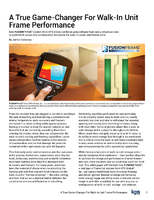Sintered Porous Plastics can help understand cancer.
Share:
Press Release Summary:

Offered in variety of shapes and sizes, ranging from 2 mm to 2 m diameter, BioVyon™ Porous Plastics are primarily made from polyethylene or polypropylene and are produced with pore sizes from 5–100 micron and porosities from 35–50%. Plastics can be molded into complex 3D shapes, or cut from roll or flat sheet. Offering chemical compatibility and resistance to most acids, bases, and temperatures up to 230°F, materials are suited for water/air filtration, sound attenuation, and vacuum table beds.
Original Press Release:
How the Evolution of Sintered Porous Plastics is Furthering our Understanding of Cancer and Other Diseases
The fight against cancer could be aided by new technical advances in filtration and separation technology.
Porvair Filtration Group believes that the evolution of its range of sintered porous plastics can help molecular biologists and clinicians better understand the mechanisms underlying cancer and other diseases.
Scientists at the Wrexham division have developed BioVyon™ porous plastic materials which can now be used in a wide variety of medical and pharmaceutical applications to offer better healthcare, improve medical knowledge and help with the diagnosis and treatment of diseases.
The utility of BioVyon™, coupled to Protein A or G or other highly selective biochemical reagents such as antibodies, opens up a whole range of new assay tools to help molecular biologists and clinicians understand diseases - and more of these assays kits are in Porvair’s product development pipeline.
BioVyon™ is a highly versatile plastic which can be employed in a wide range of functions across the entire medical sector. The requirements of materials for these market sectors are usually far more stringent than that for industrial applications.
They need to be contamination-free with very low levels of leachables and with full traceability. Regulatory approval is also an essential prerequisite for many products in these sectors.
Sintered porous plastics - whereby porous materials are produced by fusing together plastic particles using controlled application of heat - have been used for many years for a myriad of industrial processes.
These sintered materials can be made from most thermoplastic polymers but are primarily made from polyethylene or polypropylene and are typically produced with a pore size range from five to 100 micron and with porosities between 35 to 50 per cent (open volume).
Porvair’s sintered porous products are available in a wide variety of shapes and sizes, as small as 2mm or as large as 2m in diameter. They can be moulded into complex three dimensional shapes, or cut from roll or flat sheet. The defined pore size distribution combined with a material exhibiting excellent robustness and chemical resistance are essential properties for these applications.
The Vyon® range of porous materials also offer excellent chemical compatibility, exceptional strength and are resistant to most acids, bases, many organic chemicals and temperatures up to 110ºC (230ºF).
Typical industrial applications include water and air filtration, sound attenuation, fragrance emanation, vacuum table beds, powder fluidisation and battery venting.
Porvair’s Market Manager Roy Rigby said: “Since 2007 the BioVyon™ range of materials has grown. It continues to expand and is being used in such applications as drug filtration and purification, catheter vents, bone cement mixing in the operating theatre and nasal spray filters.
Now, with BioVyon™ being coupled to biomolecules such as Protein A or G, and antibodies too, a whole range of possibilities have opened up.”
Porvair’s Head of New Product Development Dr David Cowieson said: “New assay tools such as the Chromatrap® kit range are helping molecular biologists and clinicians to gain a better understanding of the causes of cancer and other common diseases.
“More tools are on the way and many of them are designed to facilitate automation for high throughput applications which could revolutionise the pace of this work.
“Our scientists have been genuinely excited by the opportunities that they have helped to realise in the laboratory that can then be implemented for wide healthcare benefits, the refinement of medical knowledge, and in the diagnosis and treatment of disease.”




